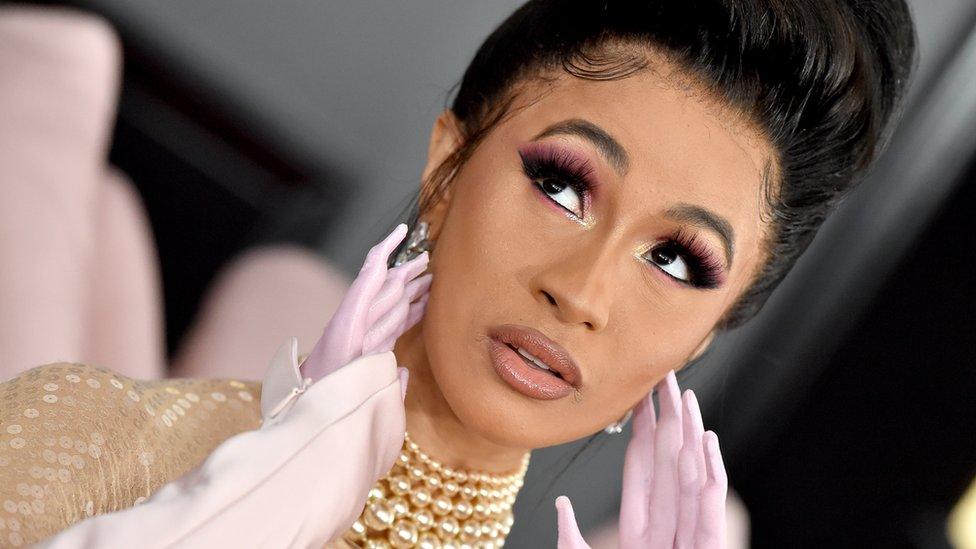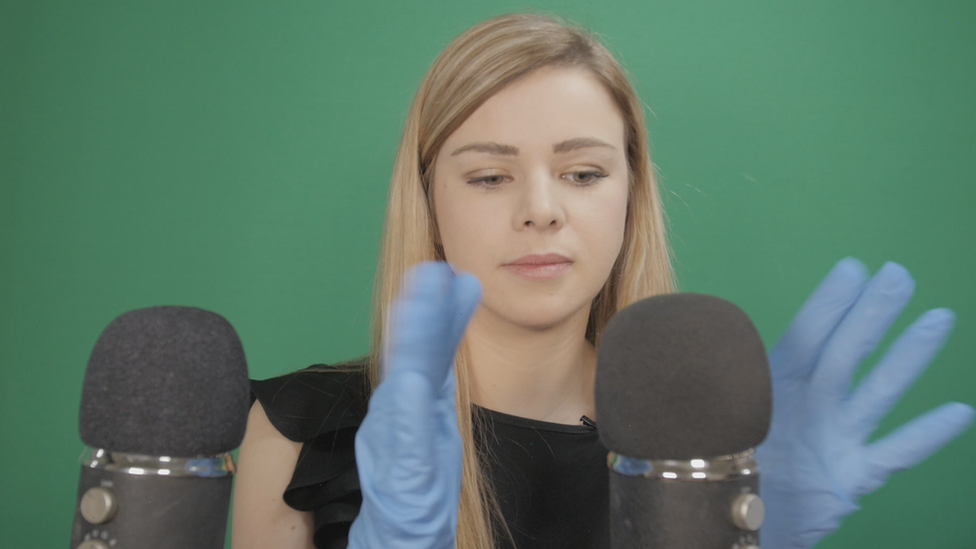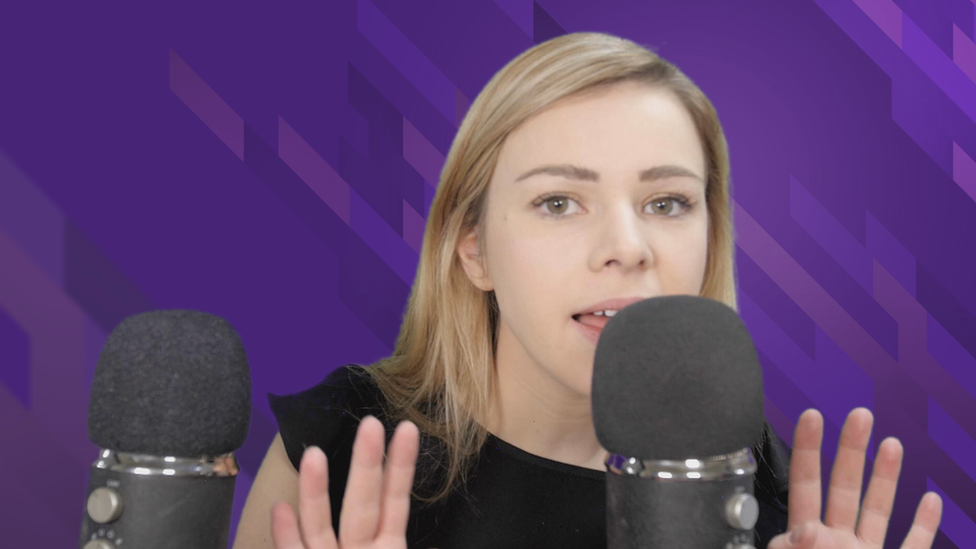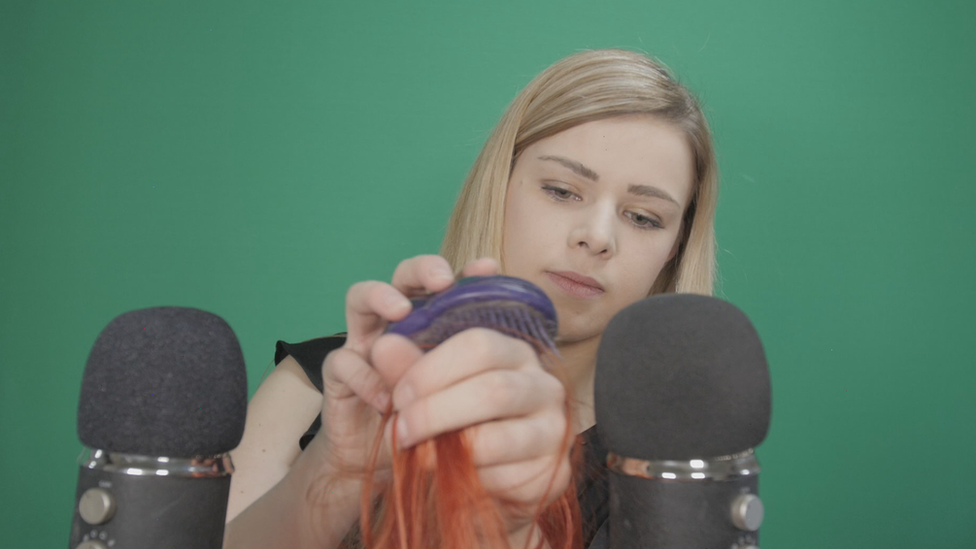ASMR: 'It helps people, it's not sexual'
- Published
Lauren's attempts to create brain tingles has attracted 125,000 subscribers
In Lauren's most popular ASMR video she "role-plays" a hairdresser, inviting the viewer to relax as she pretends to trim their beard.
"If you are a girl, it is OK to imagine you have a big beard," she says.
Why would a video of someone acting out cutting an imaginary beard be watched 700,000 times?
Lauren, whose YouTube channel is called Scottish Murmurs, says it is because of the up-close personal attention she gives and the sounds she creates such as the click of the scissors or the squelch of the shaving cream.

Hairbrushing is one of the ASMR role-plays Lauren does
"People find the video really tingly," she tells BBC Scotland's The Nine.
This brain tingle sensation is the hallmark of ASMR videos, a YouTube subgenre that continues to grow massively.
The initials stand for Autonomous Sensory Meridian Response, which sounds like a vaguely scientific term but the name actually appears to have been coined by people in the scene.
It also sounds quite sexual but Lauren is adamant that is not the case.
Instead, she says it helps people to relax, to clear their mind before sleep or even to cope with anxiety or mental health issues.

Rapper Cardi B released an ASMR video last year
In October, superstar rapper Cardi B released an ASMR video, external, signalling how popular the genre has become.
And during last month's Super Bowl an advert featured Big Little Lies actress Zoe Kravitz whispering and tapping on a beer bottle, presumably with the intention of giving shivers of delight to viewers.

What is ASMR?

Big Little Lies actress Zoe Kravitz starred in a Superbowl advert
The term is believed to have been coined by American Jennifer Allen, who started a Facebook group on the topic in 2010.
It is a physical sensation in response to specific sights and sounds.
Lauren describes the tingles generated by the videos as "the shiveries", a frisson that travels from the top of the head down the spine and can be caused by numerous different triggers.
There are more than 13 million ASMR videos on YouTube including subjects such as people having haircuts, massages and towel-folding tutorials.

'Role-play videos'

Lauren, from Glasgow, has been posting to her Scottish Murmurs channel for about two-and-a-half years and has 125,000 subscribers.
Her 200 videos have been watched about 25 million times in total.
The 24-year-old says she makes money from the channel but nowhere near as much as the big stars who earn hundreds of thousands of pounds a year.

They whisper, tap their fingers, make "mouth sounds" or act out role-play scenarios such as a doctor's appointment or a visit to the hairdresser's, all with the aim of engendering the "shiveries".
Lauren likes to make the role-play videos in which she can use her acting skills as well as her creativity in making the trigger sounds.
She uses hi-tech binaural microphones to create a 3D audio experience that makes the listener feel they are in the middle of the scene.

Lauren says she first got into ASMR at university.
"I'm one of those people who cannot study in silence," she says.
"I need to listen to music or something in the background."
"At first I found it a bit weird, the whispering felt a bit odd, but I kept listening and I found I was getting tingles and I was feeling relaxed."
Towards the end of her time at university she decided to try to make her own ASMR videos.

Her Scottish accent was instantly popular.
"A lot of people find it really relaxing, especially over in America," Lauren says.
"A really common comment is the way we say "girl", they really like the sound of that word."
She also does a series of parody videos where she lays the Scottish accent on thick and speaks like a granny.
"It's got that motherly vibe to it that people find relaxing," she says.
Whispering, role-playing, massages, creams, rubber gloves, mouth sounds and the clicking of the tongue are all popular ways of triggering that brain tingle or "head orgasm" as some have described it.

But Lauren denies there is any sexual element.
"A lot of the ASMR videos are whispering and sometimes people assume it is sexual," she says.
She likens it to yoga, the poses of which can be considered sexual and provocative.
"If you take it out of context you could make it sexual but actually ASMR itself, the tingling, the videos on YouTube, are not," she says.
According to Lauren, her purpose is to help people relax and deal with the stresses of everyday life.
Her cousin killed herself a couple of years ago and that brought home to her the struggles people have with mental health.
"A lot of people use ASMR to help them when they are feeling lonely or anxious," she says.
"I have had emails from all sorts of people explaining how much my videos have helped them."
- Published21 June 2018
